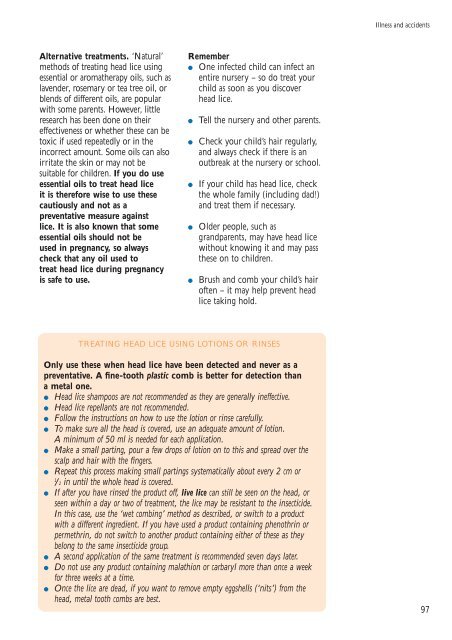Here - Health Promotion Agency
Here - Health Promotion Agency
Here - Health Promotion Agency
You also want an ePaper? Increase the reach of your titles
YUMPU automatically turns print PDFs into web optimized ePapers that Google loves.
Illness and accidents<br />
Alternative treatments. ‘Natural’<br />
methods of treating head lice using<br />
essential or aromatherapy oils, such as<br />
lavender, rosemary or tea tree oil, or<br />
blends of different oils, are popular<br />
with some parents. However, little<br />
research has been done on their<br />
effectiveness or whether these can be<br />
toxic if used repeatedly or in the<br />
incorrect amount. Some oils can also<br />
irritate the skin or may not be<br />
suitable for children. If you do use<br />
essential oils to treat head lice<br />
it is therefore wise to use these<br />
cautiously and not as a<br />
preventative measure against<br />
lice. It is also known that some<br />
essential oils should not be<br />
used in pregnancy, so always<br />
check that any oil used to<br />
treat head lice during pregnancy<br />
is safe to use.<br />
Remember<br />
● One infected child can infect an<br />
entire nursery – so do treat your<br />
child as soon as you discover<br />
head lice.<br />
●<br />
●<br />
●<br />
●<br />
●<br />
Tell the nursery and other parents.<br />
Check your child’s hair regularly,<br />
and always check if there is an<br />
outbreak at the nursery or school.<br />
If your child has head lice, check<br />
the whole family (including dad!)<br />
and treat them if necessary.<br />
Older people, such as<br />
grandparents, may have head lice<br />
without knowing it and may pass<br />
these on to children.<br />
Brush and comb your child’s hair<br />
often – it may help prevent head<br />
lice taking hold.<br />
TREATING HEAD LICE USING LOTIONS OR RINSES<br />
Only use these when head lice have been detected and never as a<br />
preventative. A fine-tooth plastic comb is better for detection than<br />
a metal one.<br />
● Head lice shampoos are not recommended as they are generally ineffective.<br />
● Head lice repellants are not recommended.<br />
● Follow the instructions on how to use the lotion or rinse carefully.<br />
● To make sure all the head is covered, use an adequate amount of lotion.<br />
A minimum of 50 ml is needed for each application.<br />
● Make a small parting, pour a few drops of lotion on to this and spread over the<br />
●<br />
●<br />
●<br />
●<br />
●<br />
scalp and hair with the fingers.<br />
Repeat this process making small partings systematically about every 2 cm or<br />
1<br />
/2 in until the whole head is covered.<br />
If after you have rinsed the product off, live lice can still be seen on the head, or<br />
seen within a day or two of treatment, the lice may be resistant to the insecticide.<br />
In this case, use the ‘wet combing’ method as described, or switch to a product<br />
with a different ingredient. If you have used a product containing phenothrin or<br />
permethrin, do not switch to another product containing either of these as they<br />
belong to the same insecticide group.<br />
A second application of the same treatment is recommended seven days later.<br />
Do not use any product containing malathion or carbaryl more than once a week<br />
for three weeks at a time.<br />
Once the lice are dead, if you want to remove empty eggshells (‘nits’) from the<br />
head, metal tooth combs are best.<br />
97
















